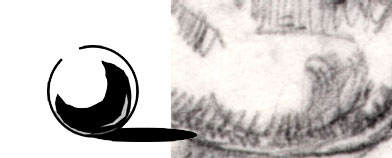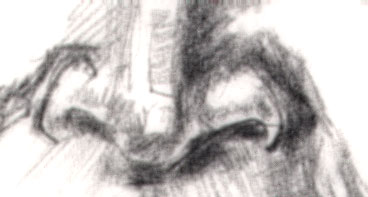|
May 5th 2001
*********************************************************
YouCanDraw.com's Insider Communiqué
*********************************************************
In today's issue:
Shadows, highlights and primitive forms
--------------------------------------------------------------------------
Howdy all! Happy Cinco De Mayo!
Today we’re going to look at shadows and highlights and their overall
effect: adding depth and contributing to the overall three-d effect of a
picture. More importantly we’ll look at how the exact same patterns you see
on a simple sphere can be found on the face. We’ll use three examples
from different parts of the face - in fact they're from Paul McCartney’s
preliminary sketches from as week ago. We’ll do this by quickly reviewing
parts of light and shadow (lesson 9) link:
http://ycdinsiders.digitalchainsaw.com/InsidersArtistLoft/lesson10.htm
Review.
A sphere is great for studying light and shadow because you get all the
parts of highlight, reflected light, and shadow contained in one little orb.
Check out illustration “1_labeled_shadows” below (It’s the sphere with the
different parts of the highlight and shadow labeled. )

Quick explanation of light’s four main categories:
The Highlight. The Highlight is the brightest light on the page or object.
This is the area where light falls at it's most direct on the object.
The Crest Shadow. This is the shadow that falls on the curved portion of a
rounded object. It covers the zone between the highlight and the reflected
light. Rarely is it one shade of shadow like it looks here. It's usually
darkest at the point farthest from both highlight and reflected light. It's
also the key in conveying three dimensionality in an object.
Reflected Light. Look for this tricky and somewhat sneaky light on any
surface. (It's actually light reflected from the environment and other
surrounding objects.)
Cast Shadow. The object stands between the light and it's foundation (i.e.
what the object rests on.) The cast shadow is usually the darkest shadow.
Just for funsies, open the next picture: “1_shpere_and_chin.jpg”. It’s actually a
clip from last week’s Paula McCartney caricature. (If you saved the picture
pull it up and see if you can’t find this part of the chin.)

...............................................1_shpere_and_chin.jpg
Looking at shadows, the curves of the face and three dimensions
Looking at one little piece of chin here note how it’s curved, how it’s shaped
just like the sphere? In fact as you’ll see, I’ve stuck the chin and the sphere
together here in this second picture. Look how similar the shadows and shapes
are. Check out the shape of the “Crescent shadow” within the chin - it’s almost
identically shaped as that of the sphere’s. Search out the highlight and the
reflected light. They’re all there, every kind of light, shadow and highlight can
be found within the chin. (The cast shadow is a little more complicated - but
it’s there, you just have to use your imagination al title.) .
Reviewing the review:
You have the highlight - the direct flare of light where the
light strikes it, the transitional shadow (or the crest shadow), the deep
shadow, and reflected light - all these can be found every shadow on the
face. Having trouble seeing the shadow shapes as clearly defined as they
are in the labeled sphere? What to do? .....
Squint!
Squint while looking at the picture of the chin: squinting will collapse the
areas of tone into more understandable shapes - shapes you can draw.
Continuous tone
If you don’t squint you’ll be perceiving “continuous tone”. What’s
“continuous tone? They’re those tiny tone gradations and values of the same
color. When you watch a sunset or a sunrise on a clear day you see generally
don’t see clear demarcations in color like you see in a rainbow. Rather you see
the fiery yellow’s and oranges in the sky closest to the sun, transitioning
to darker yellows, then oranges, then reddish purple, then deeper and deeper
purples and blues, to deep blues and purples as you look to the west.
It’s through deciphering continuous tone that your printer comes up with
it’s “16 million” colors. If there’s enough of them, enough tones, you get the
the illusion of continuous tone - and an object’s colors will look like you see it
in nature: very realistic. If there isn’t enough gradations for continuous tone,
you get that computerized “stepped” look. It doesn’t look natural, (but when
it first appeared it was a neat effect) So squint and you’ll see larger areas of
similar tone and thus shapes.
One more facial feature
Check out the nose and in particular the nostril on the right side of the
picture. (See the “1_nose.jpg” illustration - below. See the different areas
of tone? Can
you see the same shadows and highlights that were visible in
the two
previous illustrations? (There’s actually cast shadows too in this picture.)
They’re all there - but with shapes that match the shape of the nostril -
which brings us to our next mini-point today...

1_nose.jpg
Going beyond just spherical shapes - Primitive forms
I picked the chin because it’s got that embedded spherical shape that so
perfectly matches the shape of our sphere example. And I picked the nostril
because it’s well, it’s something of a modified cylinder. And what are
spheres and cylinders? They’re what all these artsy folks like to call
“primitive” forms.
Other primitive forms besides spheres: squares, cubes, cones and triangles,
circles and cylinders. Circles, triangles and squares are the primitive forms in two
dimensions. Spheres, pyramids and cubes and cones are the same shapes in
three dimensions. Cylinders and cones are second generation 3-d primitive
forms since they combine features of the most basic forms. (The side if the
nostril is closest to a cylinder in shape.)
Primitive forms on the face
Let me start you off on seeing primitive forms in other parts of the face.
In the forehead you might see a rectangle or square with a sphere buried in
the top middle part of it. The triangularis muscles running from the corners
of the mouth to the chin might be cylindrical to conical in shape. The chin
might be a conglomeration of 2 spheres, (or just one like you see in the
above example), the jaw may appear as a modified rectangle, the cheeks -
spherical, the mouth: cylindrical. the neck: another cylinder. You can uncover
lots of little planes that correspond to the underlying geometric shape.
The take home message
Heres the take home message: Everything can actually be reduced to
primitive forms . All parts of the face (or on the body, on the planet!) can
be reduced to the primitive forms. You might have to look in pretty close to
decipher them or you may have to take a step back, but you’ll find them if
you look.
So if you understand the primitive forms and how light behaves on each, you
can understand the lighting, shadows, and highlights on every part of the face
making the insurmountable almost understandable. Once you can mentally break
down each part of the face into those primitive forms, you’ll see the lighting and
shadowing make perfect sense. It has logic.
What comes after understanding light and shadow?
What comes after understanding light and shadow? Color. Color
works on the same principle as tones and grades and the shades
we’ve been looking at. It’s just the next dimension up. When we work in
gray scale or pencil (a lot of what we do around here) color isn’t
emphasized. But you are getting very close to color once you
understand the tones and values grays, black and white.
Next issue
In the next issue you’ll see a few of the primitive forms drawn out and the
light/shadow patterns explained. After that, maybe we’ll get around to
mapping out the all the primitive forms of the face.
Until then, happy drawing!
Warmly,
Jeff
Jeffrey O. Kasbohm
Executive Director
http://www.YouCanDraw.com
"Once and for all getting you drawing faces and caricatures"
mailto:comments@youcandraw.com
|